

Essay Writing for Beginners: 6-Step Guide with Examples
If you need to write an essay, whether for a college course or to pass a writing test, this guide will take you through the process step-by-step.
Even if you have never written an essay before, this guide will make the process simple and easy to follow.
It is divided into two parts.
First, I’ll show you the steps of writing an essay from scratch using a simple example.
And in the second part, we’ll go through the process together and write a complete sample essay.
Let’s dive right in.
Writing an essay is a 6-step process.
Step 1. Decide on your main point and write it down
You could be in one of the following situations:
- Your teacher or professor gave you a prompt, and you have to follow it
- You are allowed to make up your own essay topic
- You must pass a writing test and are practicing
Whatever the case, let’s assume that you have some kind of a topic or an idea for an essay. Many essay prompts ask you to decide for or against an idea. You must agree or disagree.
And in your first step, you need to simply make that decision – whether you agree or disagree – and just write it down as a simple sentence.
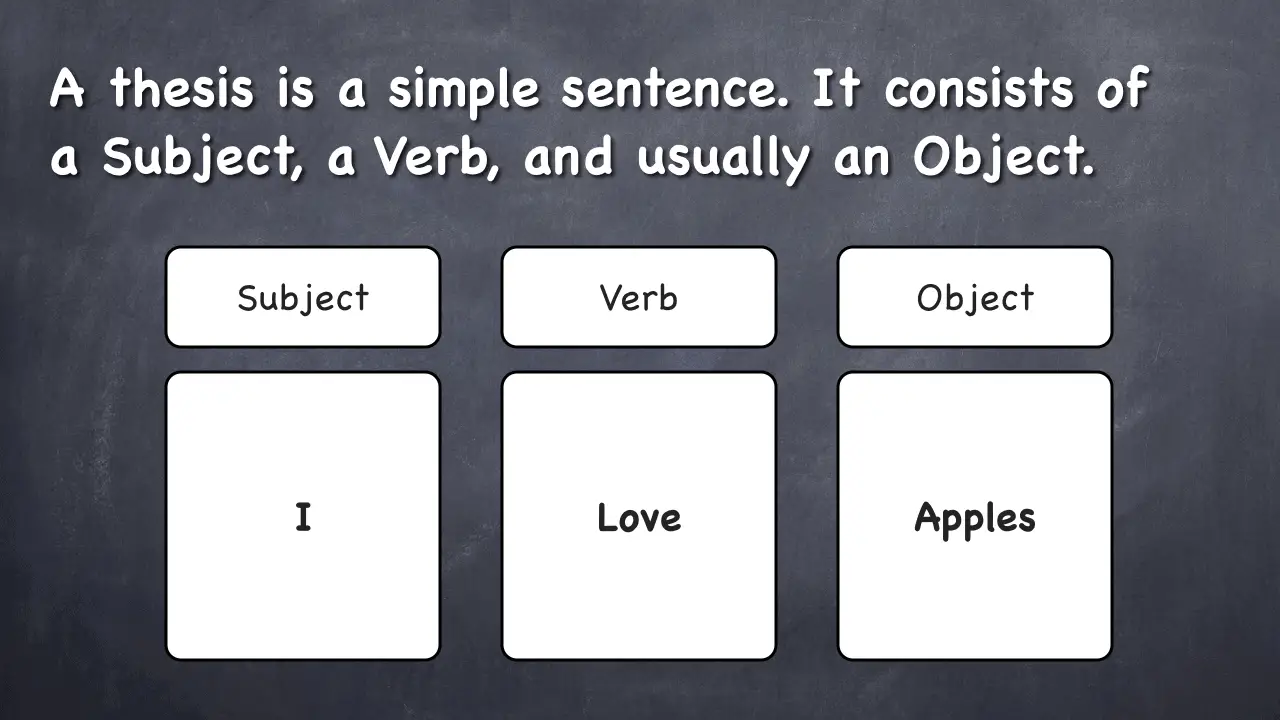
This is a very simple example, but it shows you what a thesis essentially looks like. It is also your main point.
Try not to make your thesis sentence too complicated. Keep it simple so that the point is perfectly clear to both you and the reader.
In this case, our example thesis is:
And we’re ready for the next step.
Step 2. Come up with three supporting ideas
Whether you need to write 300 or 3,000 words, as a beginner you only need three supporting points to prove your main point.
This is why I teach the Power of Three.
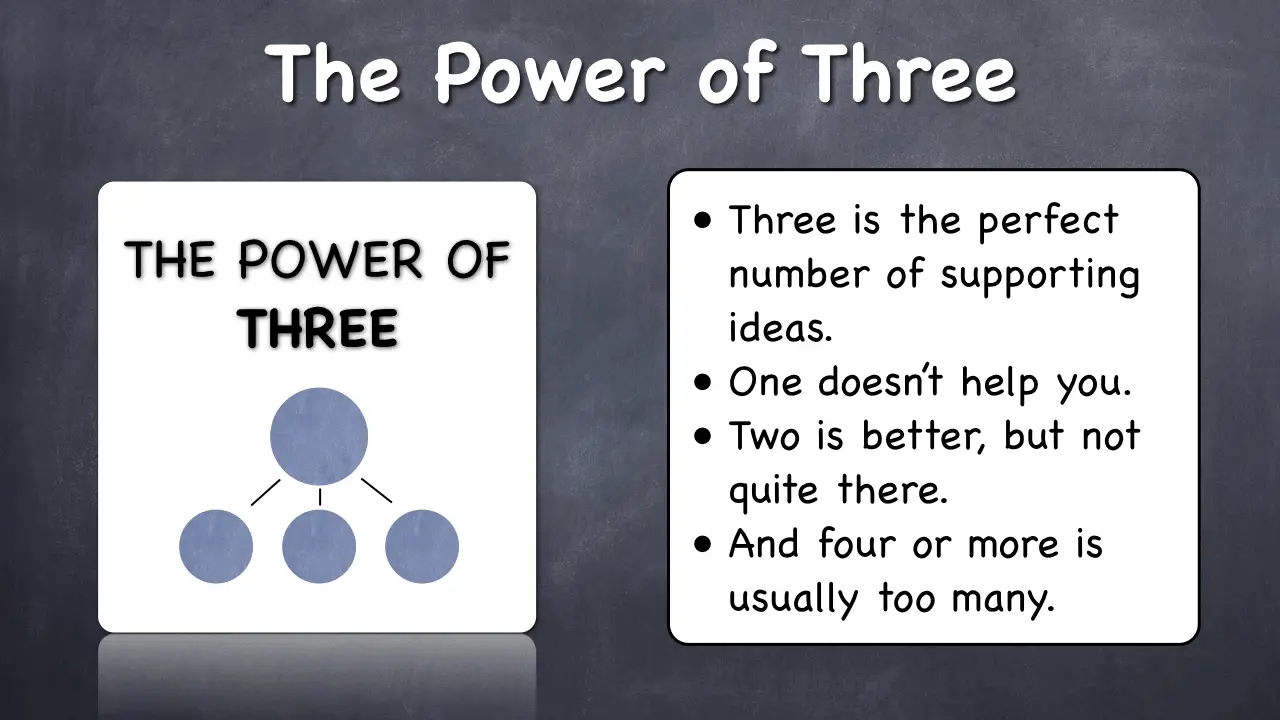
So, why three? You see, you need to divide your topic into subtopics. If you don’t, the whole essay writing process will be harder than it has to be.
If you divide it into only two parts, that’s okay. But it doesn’t give you enough meat when you’ll be writing the body of the essay.
If you divide it into more than three, that is also a recipe for frustration. It’s just too many.
Three is a very comfortable number for the brain to deal with. Trust me. I’ve taught many, many people.
Let’s apply the Power of Three to our simple example.
Why do I love apples? I love them for three reasons. Not one, not two, not seven. Just three reasons.
I love apples because they are:
- Nutritious
In this step, your job is to make sure that these three reasons are really different from one another. In this case, they are.
Here is a wrong way to do it:
In this case, apples being filling is too similar to being nutritious. This means that when you’re writing the body of the essay, you may run into writer’s block.
This happens because you realize that you’ve already said everything there is to say about the nutrition of apples, and now them being filling is too closely related. And you’re out of words to write.
Don’t let that happen. Just keep your supporting points really distinct from one another.
Step 3. Write out the complete thesis statement
Now you have everything you need to write a complete thesis statement. You have your main and supporting points.
Take them and write them out as complete sentences in one paragraph. Let’s do it very simplistically, using our apples example:
Again, this is overly simple, and I don’t expect you to write such short sentences one after another this way.
But it’s crystal clear. And the supporting points really sound like good evidence for the main point.
In other words, this thesis statement works.
Your Thesis Statement Is Also Your Outline
Students often ask how to write an essay outline. But once you have written your thesis statement the way I just showed you, you have yourself a nice outline.
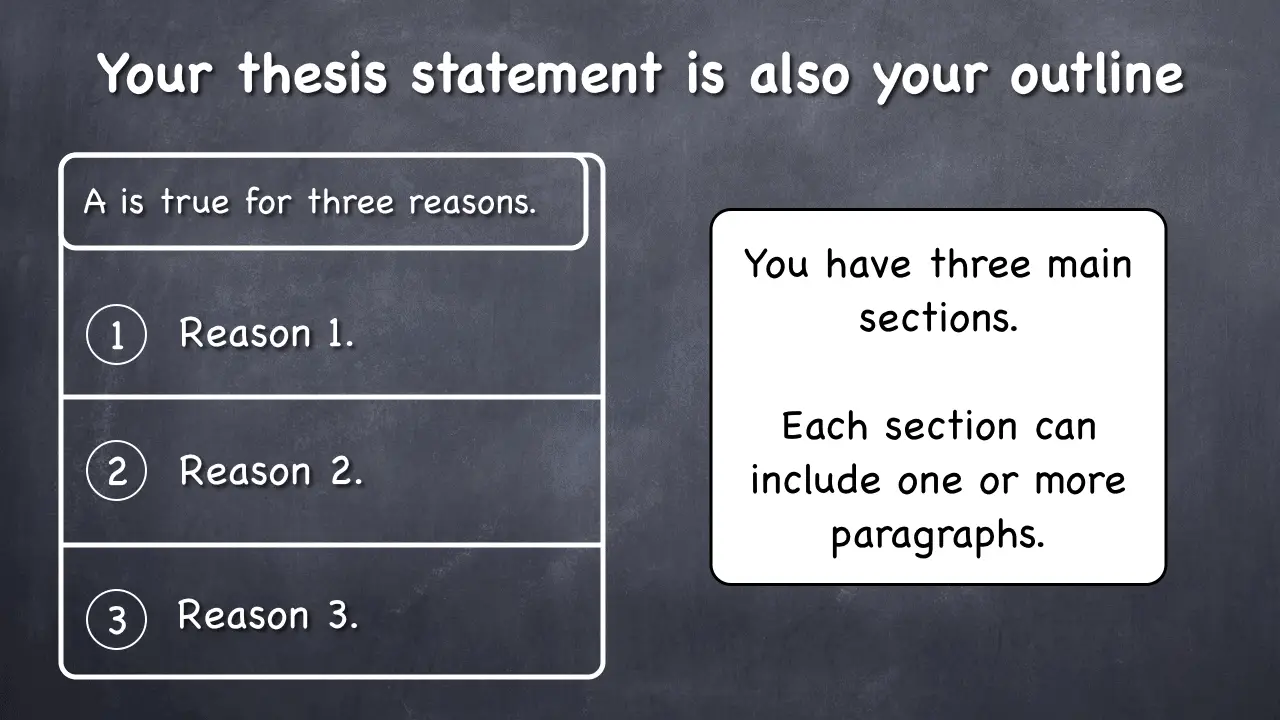
In addition, you already have the first paragraph. It may not be complete. You may choose to add some words to it. You will also add an introduction in a later step.
But your first paragraph is, for the main, done. It exists, and it’s good to know that you just wrote a nice paragraph.
We are ready for the next step.
Step 4. Write the body of the essay
We already know that we have three sections in our little example. And you will also have three main sections if you apply the Power of Three to your essay.
Each of your sections will contain one or more paragraphs.
But as a beginner, just stick to one paragraph per section. Each of your sections will be a paragraph, and you need to write only three paragraphs in the body of the essay.
Body Paragraph Structure
You must begin each of your body paragraphs with a lead sentence (also known as a topic sentence). And then your job is to fill the rest of the paragraph with evidence to support what you just stated in the lead sentence.
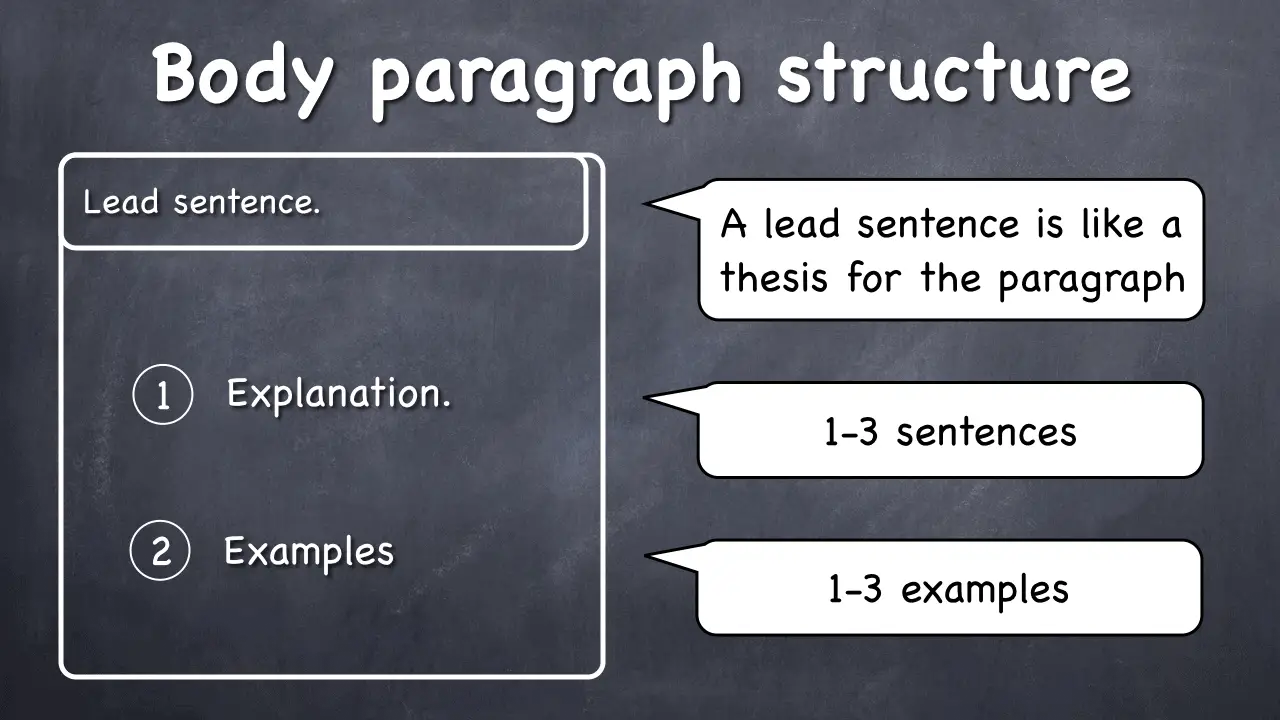
You may have heard that in your essay you should proceed from more general to more specific ? That is exactly right.
The lead sentence (the first sentence in the paragraph) is the most general statement in that paragraph.
For example, in our essay about apples, the second section is about how nutritious apples are. So, you would begin your paragraph with something like this:
This is the most general statement. And now, your job would be to unpack that, to write a little more specifically.
As an explanation , you can write a sentence or two on what kinds of nutrients apples contain.
And as examples , you can write about what some of these nutrients do in the body that makes them nutritious.
Does this make sense? You are proceeding from general to specific. We’ll take a closer look at this process in the essay topic sample that is coming up.
Once you’ve written the body paragraphs, you’re ready for the next step.
Step 5. Write the introduction and the conclusion
Introductions.
The introduction is really just a sentence (two at most) that you add in the beginning of your first paragraph.
Introductions are not necessary. Many instructors will expect that you write them while others won’t. You can go straight to the point by starting your first paragraph with the thesis.
However, most instructors will expect an introduction, and you should know how to write one.
To write an introduction, just zoom out a bit and write a more general and less relevant sentence. For example, we can start our essay about apples with this sentence:
And then we proceed straight to the thesis: “I love apples.” And so on…
Conclusions
In your conclusion you can do one of several things. But I recommend that, as a beginner, you stick to the time-proven restatement .
Basically, you simply repeat what you stated in your thesis statement, using different words.
Yes, this is repetitious, but that is the nature of conclusions. Don’t worry.
You can literally copy your thesis statement, paste it at the end of your essay, and make sure you change the wording so that it reads like a new paragraph.
For example, this is how we can write our conclusion about apples:
Yes, your conclusion can be just one sentence. But it can also contain many sentences.
Step 6. Proofread
Our final step in writing an essay is to go back and proofread our draft.
We must look out for:
- Any contradictions (to make sure we don’t contradict our own points)
- Any irrelevant material (stuff that doesn’t belong in the essay at all)
- Grammatical errors
- Misspellings
One good, thorough round of proofreading can be enough to be ready to submit your essay for grading.
You can use a variety of tools sto spell-check your essay. Google docs is one great tool for that. But many others, such as Grammarly, are available as well.
Guess what! Now you know how to write an essay, even if you’re a beginner.
And now, let’s apply what we learned.
Let’s take a sample topic and follow the 6 steps to write a nice sample essay.
Let’s do this!
Sample Essay: “Parents are the best teachers.”
This essay topic came from one of my readers. Let’s develop it into an essay by following the steps we just learned.
Step 1. Decide on the main point and write it
Let’s say that we are given a choice – whether we agree or disagree that parents are the best teachers.
All we have to do is take a stand. We have to simply decide – yes or no.
Let’s decide that parents are indeed the best teachers.
We simply state this as the main point:
Step 2. Think up three supporting ideas
Why could parents be the best teachers?
This will take some thinking. But that’s what we need to do.
Let’s use the Power of Three . And here is what we came up with:
- They are the first teachers, and that’s very important.
- They have the child’s best interests in mind.
- They spend more time with their child than anyone else.
We really want to make sure that these supporting points are different from one another. Are they?
If we read them over, we’ll see that each of them is indeed distinct. Great!
Step 3. Write out the thesis statement
We have our main point. We have our supporting points. And writing the full thesis statement is now easy.
Let’s do it:
We really just took the thesis and the supporting statements and wrote them all in a sequence as one paragraph.
As a result, we now have a nice, clear opening paragraph.
We also now have our outline:
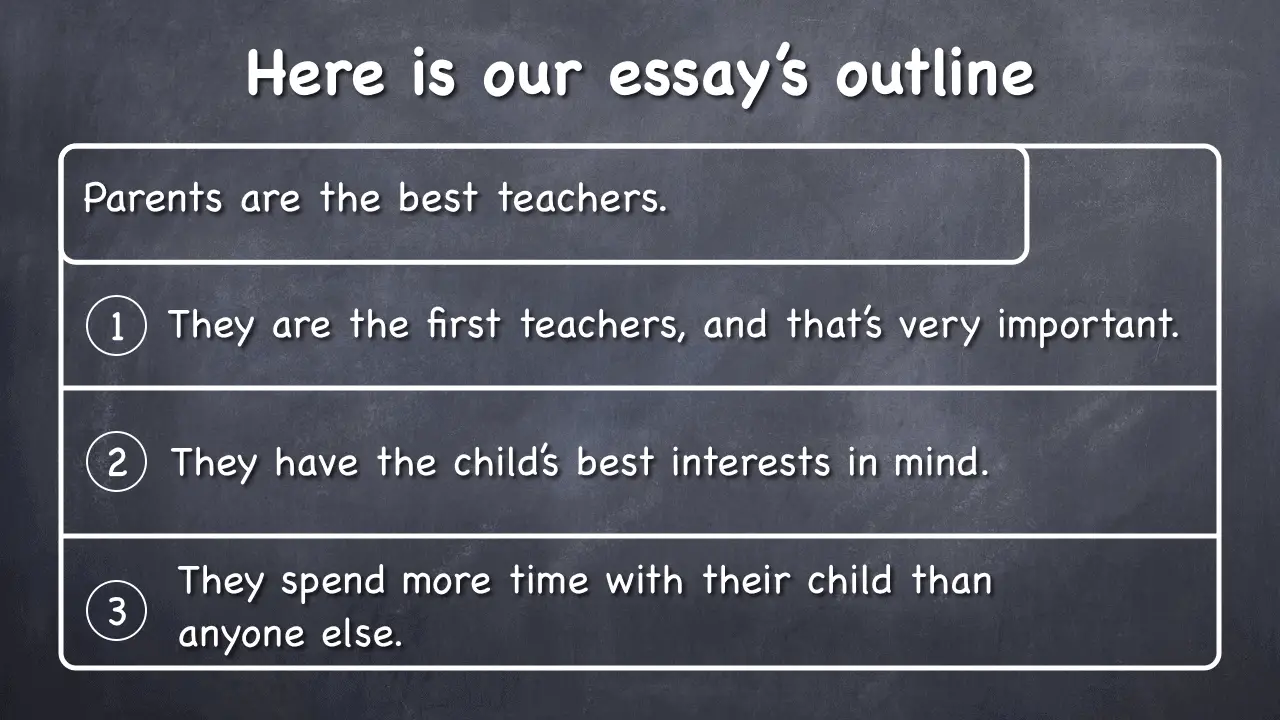
We know exactly how many sections our essay will have.
We also know in which order we’ll be presenting our support. It’s all in the thesis statement, which is also our outline.
Now our job is to write three good supporting paragraphs, one at a time.
Let’s start with the first body paragraph.
The first sentence is always the lead sentence – the most general sentence in a body paragraph.
Writing the Lead Sentence
Let’s first copy and paste our first supporting point from our thesis statement:
I copied this because this is exactly what my paragraph is about. And this would be a perfect lead sentence if it were not repetitious.
To make sure it’s not simply repetitious, we’ll tweak and expand it a little:
We made sure that the subject is clear – that it is not “ They ” but “ Parents .”
And we expanded the sentence by adding an explanation: “…because what is imprinted early stays with the child forever.”
You don’t have to necessarily add an explanation in the lead sentence like this. But this is an option that you have.
All we really want to do in the lead sentence is just expand it slightly over the initial supporting point that it came from.
Writing the Rest of the Paragraph
Let’s review our body paragraph structure:
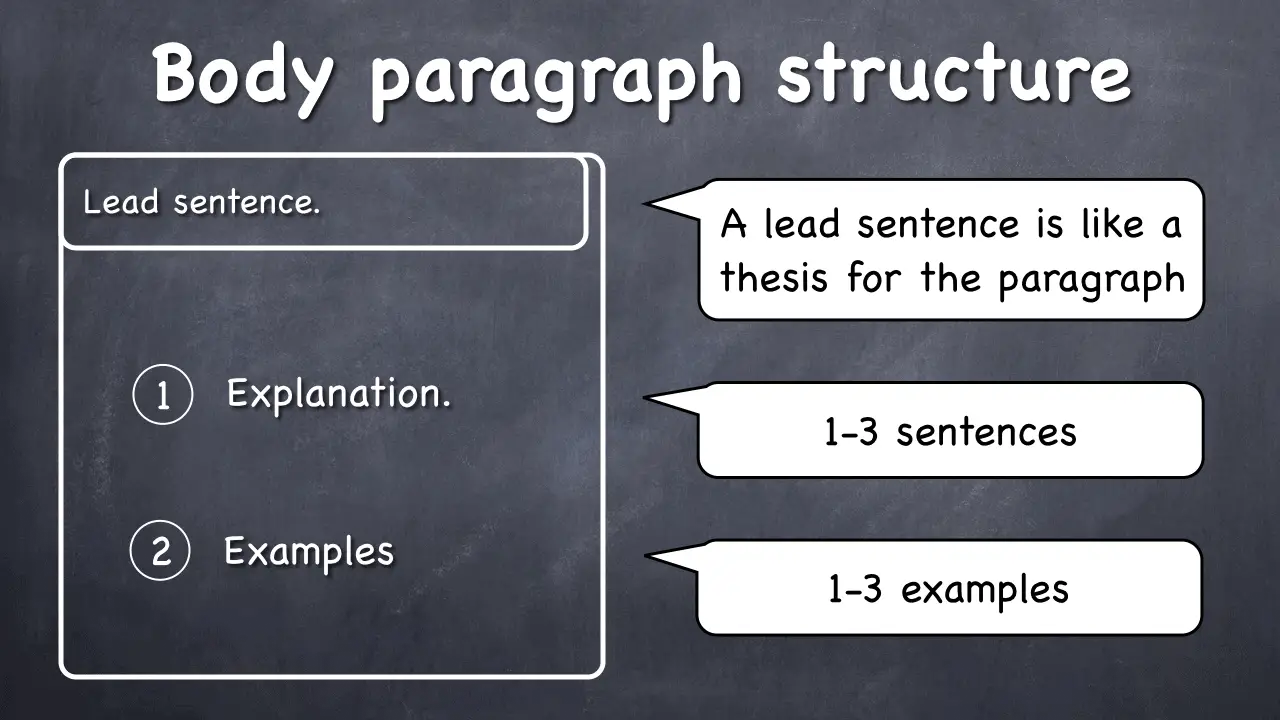
In our paragraph, we proceed from more general to more specific. Our lead sentence is the most general statement.
The next most general part of the paragraph is where you explain your point. You can provide a scientific explanation with data and research. You can explain it logically, using your own rationale.
But it is still a general part. Let’s write it.
Explanation
We are keeping it simple and not using any references to scientific studies. You can and should cite sources in your essay when necessary.
If you’re writing an essay in an exam or test, you won’t need any references. You can just make things up as you go along. And it works as long as your content is logical and supports the main point.
If you’re writing for a college course, you will likely need to cite sources, unless it’s English 101 where you write basic essays like this one.
But now, we have three explanatory sentences in our paragraph. Our next step is to add at least one example. You can add more, but one should do it for a beginner.
This example presents a phenomenon that is well known in psychology. It is an example because it describes one extreme kind of a phenomenon. It is also much more specific than our explanation.
Note that we can add more words by talking about a specific wild child from history. But let’s stop here and look at our full paragraph:
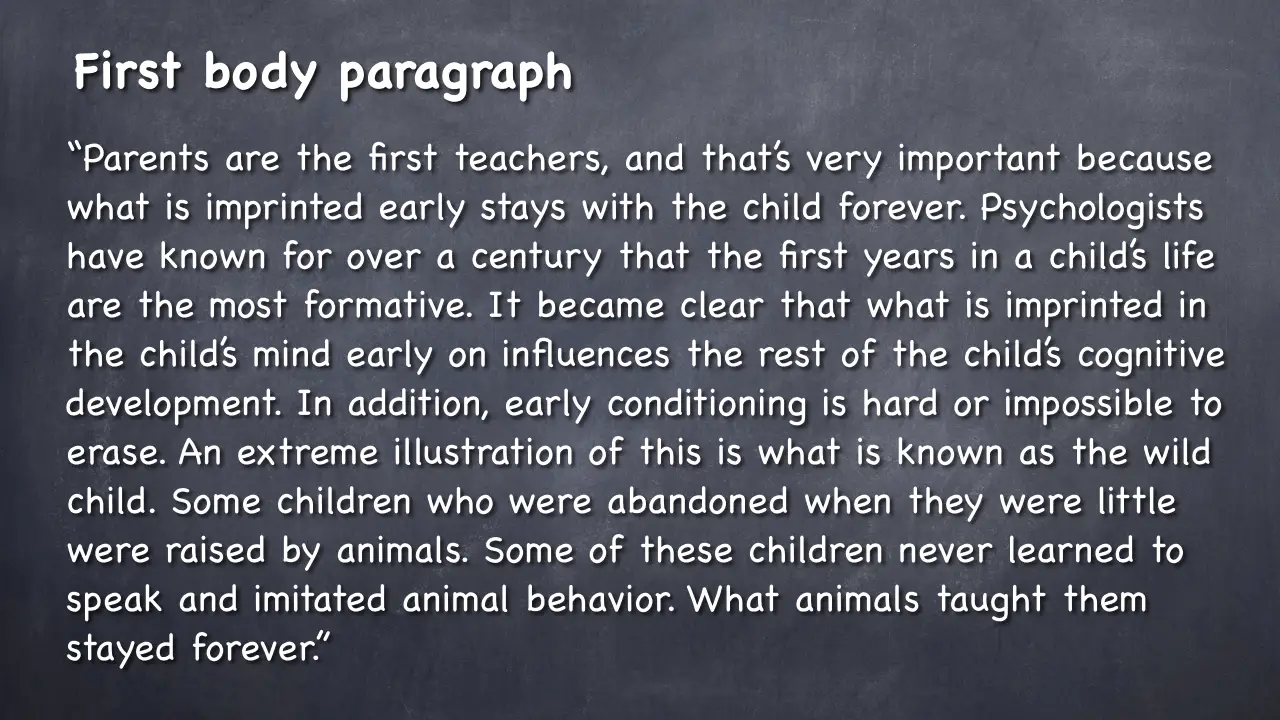
We have 113 words in this paragraph. And it’s a perfect body paragraph that supports the first part of our thesis statement.
Let’s write the next one.
Again, let’s copy the second supporting point and then tweak and expand it.
This sentence already starts with the subject, which is “ parents .” Now, all we need to do is to expand it slightly:
We added a short phrase just to make the lead sentence a little longer and more detailed. Now it doesn’t read like plain repetition.
Let’s write the next most general part of this paragraph – the explanation:
These three sentences explain why it makes sense that parents would have the child’s best interests in mind. She is the most precious thing to them in the world.
It’s time for an example. And I’ll use my personal experience:
It’s totally okay to use personal examples in an essay. You can use them even in advanced research papers. Your personal experience is valuable. Use it.
Let’s take a look at our second body paragraph in its entirety:
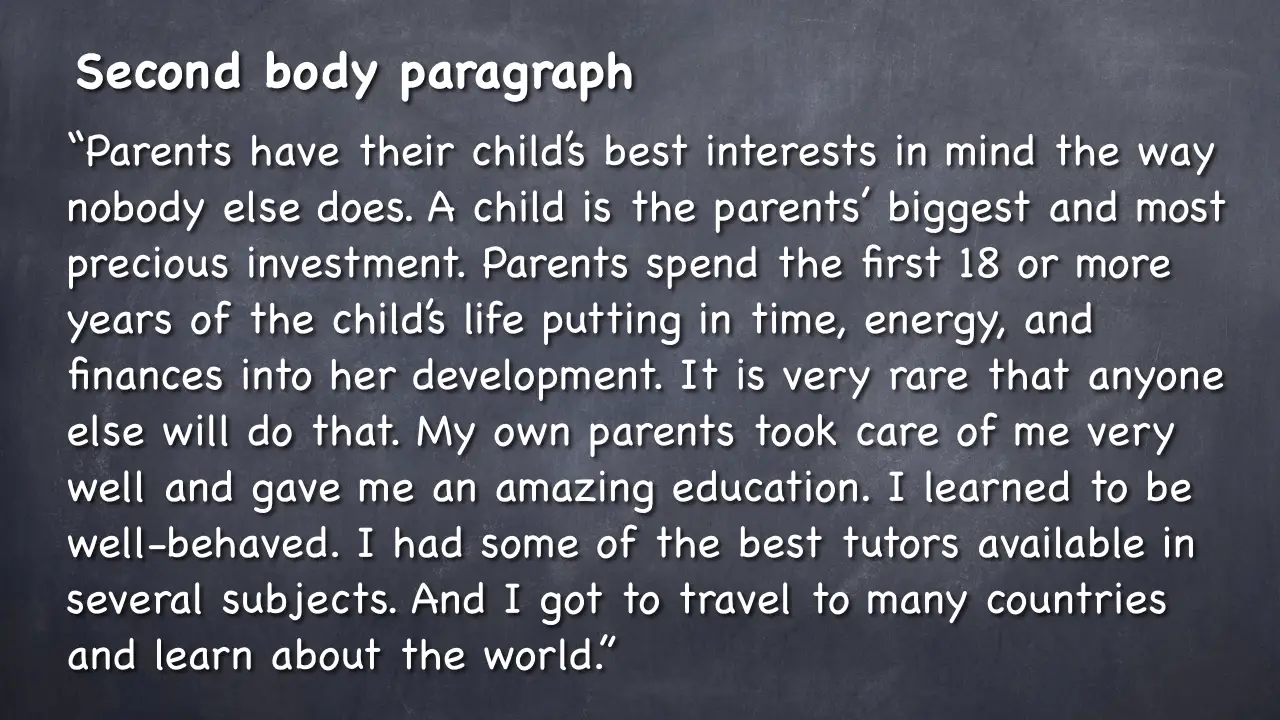
This paragraph contains 98 words of evidence to support the second point.
It’s time for the final body paragraph.
Again, you know what we’ll do. We’ll just copy our third supporting point and tweak and expand it a little:
Let’s make sure the reader knows what the real subject is in this sentence. And let’s also expand it just a bit:
Great! It’s time for the explanatory part:
Again, we won’t be citing any sources here and will keep it simple. This explanation works really well because it provides evidence for the third supporting point.
Let’s be even more specific and write at least one example.
Again, I’m using a personal example to show that whoever spends the most time with the child will have the most influence.
And let’s take a look at our third body paragraph as a whole:
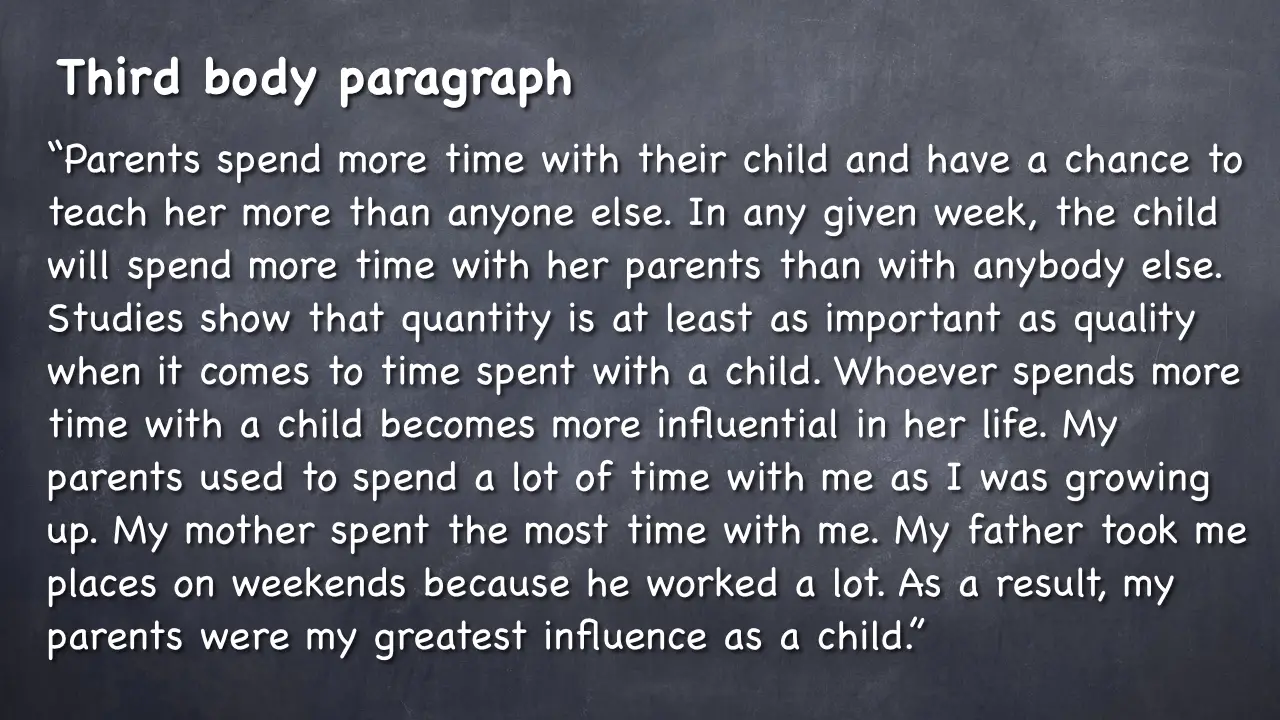
We have here 116 words of great, general-to-specific content that supports our third point.
As a result, if we look back at what we’ve done, we’ll see that everything we wrote in the body paragraphs supports the main point that parents are the best teachers.
It’s time for the next step.
Introduction
Our introduction will be just one sentence, which is enough.
First, let’s revisit our complete thesis statement. We will write the introductory sentence based on it.
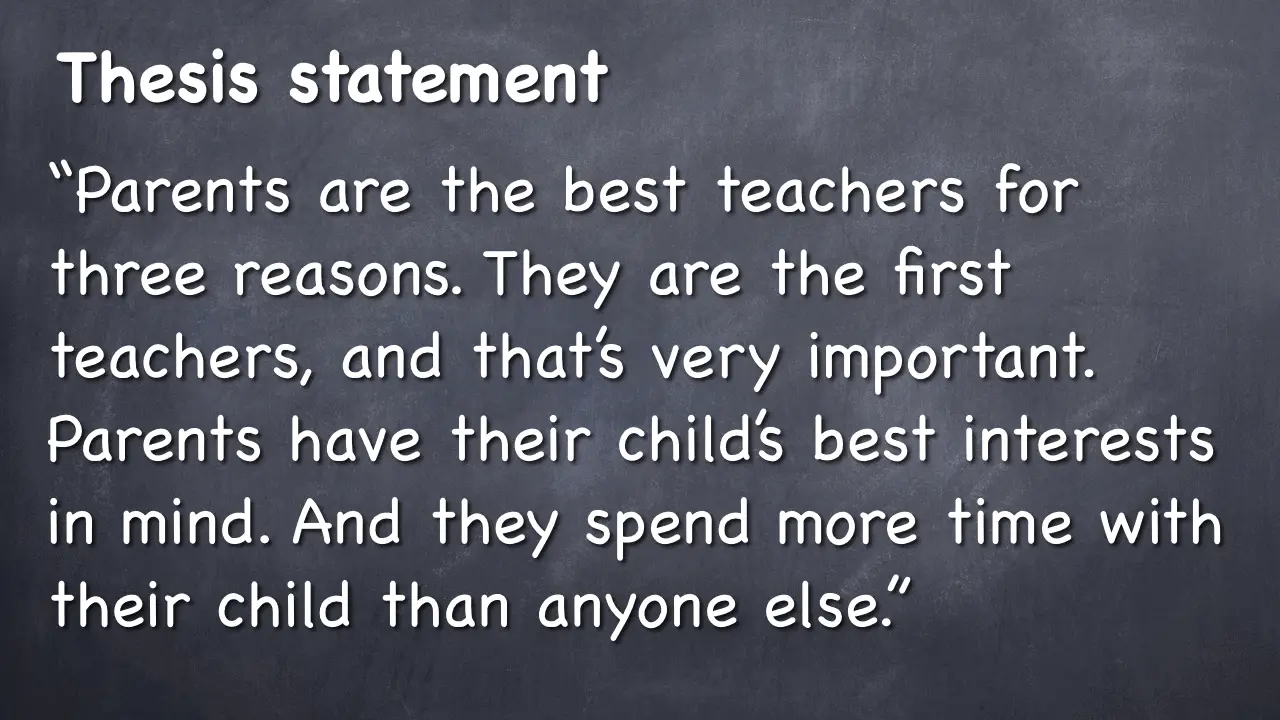
In this paragraph, we go straight to the point, and there’s nothing wrong with that.
However, as we know, most instructors will expect some kind of an introduction. So, we’ll add one sentence before we get to the main point.
This sentence must be more general. We are zooming out a little. Let’s do it:
And let’s take a look at the full paragraph together with the introduction:
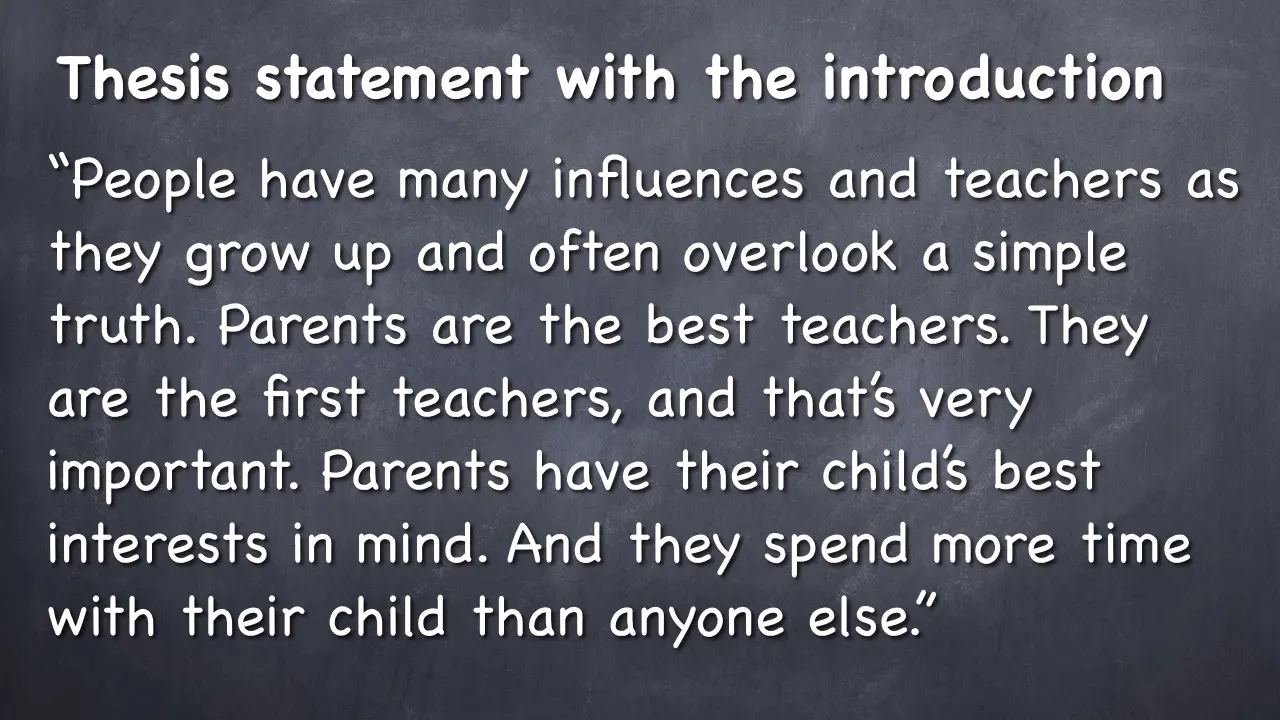
Note that I took out the phrase “for three reasons.” It is unnecessary because it is clear that you are providing three supporting points. And the whole paragraph sounds better this way.
To write the conclusion, we’ll simply reword the thesis statement. We only need to make sure that we don’t sound like we’re just repeating things.
That was not too hard, was it?
It’s time for the final step.
In this step, we just need to go over our essay, making final edits and corrections. And that’s all.
I hope this tutorial really helps you in your essay writing.
Stay tuned and we’ll talk soon!
How to Write a 300 Word Essay – Simple Tutorial
How to expand an essay – 4 tips to increase the word count, 10 solid essay writing tips to help you improve quickly, 6 simple ways to improve sentence structure in your essays.
Tutor Phil is an e-learning professional who helps adult learners finish their degrees by teaching them academic writing skills.
You Might Also Like...
How to Paraphrase in an Essay - Tutorial with Examples
https://youtu.be/1cCD66urqwo Paraphrasing is expressing the contents of a passage in different words. It allows the student to use other people’s content without copying or...
How to Expand an Essay - 4 Tips to Increase the Word Count
Do you feel that you’ve written all you could in this essay, but it’s still short of the word count requirement? Maybe you need to add a few hundred or even a thousand words. If so, you’ve...
- PRO Courses Guides New Tech Help Pro Expert Videos About wikiHow Pro Upgrade Sign In
- EDIT Edit this Article
- EXPLORE Tech Help Pro About Us Random Article Quizzes Request a New Article Community Dashboard This Or That Game Forums Popular Categories Arts and Entertainment Artwork Books Movies Computers and Electronics Computers Phone Skills Technology Hacks Health Men's Health Mental Health Women's Health Relationships Dating Love Relationship Issues Hobbies and Crafts Crafts Drawing Games Education & Communication Communication Skills Personal Development Studying Personal Care and Style Fashion Hair Care Personal Hygiene Youth Personal Care School Stuff Dating All Categories Arts and Entertainment Finance and Business Home and Garden Relationship Quizzes Cars & Other Vehicles Food and Entertaining Personal Care and Style Sports and Fitness Computers and Electronics Health Pets and Animals Travel Education & Communication Hobbies and Crafts Philosophy and Religion Work World Family Life Holidays and Traditions Relationships Youth
- Browse Articles
- Learn Something New
- Quizzes Hot
- Happiness Hub
- This Or That Game
- Train Your Brain
- Explore More
- Support wikiHow
- About wikiHow
- Log in / Sign up
- Education and Communications
- College University and Postgraduate
- Academic Writing
How to Write an Essay
Last Updated: July 22, 2024 Fact Checked
This article was co-authored by Christopher Taylor, PhD and by wikiHow staff writer, Megaera Lorenz, PhD . Christopher Taylor is an Adjunct Assistant Professor of English at Austin Community College in Texas. He received his PhD in English Literature and Medieval Studies from the University of Texas at Austin in 2014. There are 18 references cited in this article, which can be found at the bottom of the page. This article has been fact-checked, ensuring the accuracy of any cited facts and confirming the authority of its sources. This article has been viewed 7,997,843 times.
An essay is a common type of academic writing that you'll likely be asked to do in multiple classes. Before you start writing your essay, make sure you understand the details of the assignment so that you know how to approach the essay and what your focus should be. Once you've chosen a topic, do some research and narrow down the main argument(s) you'd like to make. From there, you'll need to write an outline and flesh out your essay, which should consist of an introduction, body, and conclusion. After your essay is drafted, spend some time revising it to ensure your writing is as strong as possible.
Understanding Your Assignment

- The compare/contrast essay , which focuses on analyzing the similarities and differences between 2 things, such as ideas, people, events, places, or works of art.
- The narrative essay , which tells a story.
- The argumentative essay , in which the writer uses evidence and examples to convince the reader of their point of view.
- The critical or analytical essay, which examines something (such as a text or work of art) in detail. This type of essay may attempt to answer specific questions about the subject or focus more generally on its meaning.
- The informative essay , that educates the reader about a topic.

- How long your essay should be
- Which citation style to use
- Formatting requirements, such as margin size , line spacing, and font size and type
Christopher Taylor, PhD
Christopher Taylor, Professor of English, tells us: "Most essays will contain an introduction, a body or discussion portion, and a conclusion. When assigned a college essay, make sure to check the specific structural conventions related to your essay genre , your field of study, and your professor's expectations."

- If you're doing a research-based essay , you might find some inspiration from reading through some of the major sources on the subject.
- For a critical essay, you might choose to focus on a particular theme in the work you're discussing, or analyze the meaning of a specific passage.

- If you're having trouble narrowing down your topic, your instructor might be able to provide guidance or inspiration.
Planning and Organizing Your Essay

- Academic books and journals tend to be good sources of information. In addition to print sources, you may be able to find reliable information in scholarly databases such as JSTOR and Google Scholar.
- You can also look for primary source documents, such as letters, eyewitness accounts, and photographs.
- Always evaluate your sources critically. Even research papers by reputable academics can contain hidden biases, outdated information, and simple errors or faulty logic.
Tip: In general, Wikipedia articles are not considered appropriate sources for academic writing. However, you may be able to find useful sources in the “References” section at the end of the article.

- You might find it helpful to write your notes down on individual note cards or enter them into a text document on your computer so you can easily copy, paste , and rearrange them however you like.
- Try organizing your notes into different categories so you can identify specific ideas you'd like to focus on. For example, if you're analyzing a short story , you might put all your notes on a particular theme or character together.

- For example, if your essay is about the factors that led to the end of the Bronze Age in the ancient Middle East, you might focus on the question, “What role did natural disasters play in the collapse of Late Bronze Age society?”

- One easy way to come up with a thesis statement is to briefly answer the main question you would like to address.
- For example, if the question is “What role did natural disasters play in the collapse of Late Bronze Age society?” then your thesis might be, “Natural disasters during the Late Bronze Age destabilized local economies across the region. This set in motion a series of mass migrations of different peoples, creating widespread conflict that contributed to the collapse of several major Bronze Age political centers.”

- When you write the outline, think about how you would like to organize your essay. For example, you might start with your strongest arguments and then move to the weakest ones. Or, you could begin with a general overview of the source you're analyzing and then move on to addressing the major themes, tone, and style of the work.
- Introduction
- Point 1, with supporting examples
- Point 2, with supporting examples
- Point 3, with supporting examples
- Major counter-argument(s) to your thesis
- Your rebuttals to the counter-argument(s)
Drafting the Essay

- For example, if you're writing a critical essay about a work of art, your introduction might start with some basic information about the work, such as who created it, when and where it was created, and a brief description of the work itself. From there, introduce the question(s) about the work you'd like to address and present your thesis.
- A strong introduction should also contain a brief transitional sentence that creates a link to the first point or argument you would like to make. For example, if you're discussing the use of color in a work of art, lead-in by saying you'd like to start with an overview of symbolic color use in contemporary works by other artists.
Tip: Some writers find it helpful to write the introduction after they've written the rest of the essay. Once you've written out your main points, it's easier to summarize the gist of your essay in a few introductory sentences.

- For example, your topic sentence might be something like, “Arthur Conan Doyle's Sherlock Holmes stories are among the many literary influences apparent in P. G. Wodehouse's Jeeves novels.” You could then back this up by quoting a passage that contains a reference to Sherlock Holmes.
- Try to show how the arguments in each paragraph link back to the main thesis of your essay.

- When creating transitions, transitional phrases can be helpful. For example, use words and phrases such as “In addition,” “Therefore,” “Similarly,” “Subsequently,” or “As a result.”
- For example, if you've just discussed the use of color to create contrast in a work of art, you might start the next paragraph with, “In addition to color, the artist also uses different line weights to distinguish between the more static and dynamic figures in the scene.”

- For example, if you're arguing that a particular kind of shrimp decorates its shell with red algae to attract a mate, you'll need to address the counterargument that the shell decoration is a warning to predators. You might do this by presenting evidence that the red shrimp are, in fact, more likely to get eaten than shrimp with undecorated shells.

- The way you cite your sources will vary depending on the citation style you're using. Typically, you'll need to include the name of the author, the title and publication date of the source, and location information such as the page number on which the information appears.
- In general, you don't need to cite common knowledge. For example, if you say, “A zebra is a type of mammal,” you probably won't need to cite a source.
- If you've cited any sources in the essay, you'll need to include a list of works cited (or a bibliography ) at the end.

- Keep your conclusion brief. While the appropriate length will vary based on the length of the essay, it should typically be no longer than 1-2 paragraphs.
- For example, if you're writing a 1,000-word essay, your conclusion should be about 4-5 sentences long. [16] X Research source
Revising the Essay

- If you don't have time to spend a couple of days away from your essay, at least take a few hours to relax or work on something else.

- Excessive wordiness
- Points that aren't explained enough
- Tangents or unnecessary information
- Unclear transitions or illogical organization
- Spelling , grammar , style, and formatting problems
- Inappropriate language or tone (e.g., slang or informal language in an academic essay)

- You might have to cut material from your essay in some places and add new material to others.
- You might also end up reordering some of the content of the essay if you think that helps it flow better.

- Read over each line slowly and carefully. It may be helpful to read each sentence out loud to yourself.
Tip: If possible, have someone else check your work. When you've been looking at your writing for too long, your brain begins to fill in what it expects to see rather than what's there, making it harder for you to spot mistakes.

Expert Q&A

Reader Videos
Share a quick video tip and help bring articles to life with your friendly advice. Your insights could make a real difference and help millions of people!
You Might Also Like

- ↑ https://www.yourdictionary.com/articles/essay-types
- ↑ https://students.unimelb.edu.au/academic-skills/resources/essay-writing/six-top-tips-for-writing-a-great-essay
- ↑ https://owl.purdue.edu/owl/general_writing/common_writing_assignments/research_papers/choosing_a_topic.html
- ↑ https://writingcenter.fas.harvard.edu/tips-reading-assignment-prompt
- ↑ https://library.unr.edu/help/quick-how-tos/writing/integrating-sources-into-your-paper
- ↑ https://advice.writing.utoronto.ca/researching/notes-from-research/
- ↑ https://writingcenter.fas.harvard.edu/pages/developing-thesis
- ↑ https://writingcenter.fas.harvard.edu/pages/outlining
- ↑ https://lsa.umich.edu/sweetland/undergraduates/writing-guides/how-do-i-write-an-intro--conclusion----body-paragraph.html
- ↑ https://owl.purdue.edu/owl/general_writing/academic_writing/essay_writing/argumentative_essays.html
- ↑ https://writingcenter.unc.edu/tips-and-tools/transitions/
- ↑ https://lsa.umich.edu/sweetland/undergraduates/writing-guides/how-do-i-incorporate-a-counter-argument.html
- ↑ https://www.plagiarism.org/article/how-do-i-cite-sources
- ↑ https://writingcenter.unc.edu/tips-and-tools/conclusions/
- ↑ https://www.utsc.utoronto.ca/twc/sites/utsc.utoronto.ca.twc/files/resource-files/Intros-Conclusions.pdf
- ↑ https://owl.purdue.edu/owl/general_writing/the_writing_process/proofreading/steps_for_revising.html
- ↑ https://open.lib.umn.edu/writingforsuccess/chapter/8-4-revising-and-editing/
- ↑ https://writing.ku.edu/writing-process
About This Article

If you need to write an essay, start by gathering information from reputable sources, like books from the library or scholarly journals online. Take detailed notes and keep track of which facts come from which sources. As you're taking notes, look for a central theme that you're interested in writing about to create your thesis statement. Then, organize your notes into an outline that supports and explains your thesis statement. Working from your outline, write an introduction and subsequent paragraphs to address each major point. Start every paragraph with a topic sentence that briefly explains the main point of that paragraph. Finally, finish your paper with a strong conclusion that sums up the most important points. For tips from our English Professor co-author on helpful revision techniques, keep reading! Did this summary help you? Yes No
- Send fan mail to authors
Reader Success Stories
Muhammad Talha Javaid
Feb 7, 2019
Did this article help you?

Gabrielle Mattijetz
May 8, 2017
Shahzad Saleem
Jun 20, 2018
Barbara Gonzalez
Aug 6, 2016
Kniziel Sanders
Oct 17, 2017

Featured Articles

Trending Articles

Watch Articles

- Terms of Use
- Privacy Policy
- Do Not Sell or Share My Info
- Not Selling Info
Get all the best how-tos!
Sign up for wikiHow's weekly email newsletter

Home > Blog > Tips for Online Students > How To Write An Essay: Beginner Tips And Tricks
Tips for Online Students , Tips for Students
How To Write An Essay: Beginner Tips And Tricks
Updated: October 24, 2024
Published: June 22, 2021

Many students dread writing essays, but essay writing is an important skill to develop in high school, university, and even into your future career. By learning how to write an essay properly, the process can become more enjoyable and you’ll find you’re better able to organize and articulate your thoughts.
When writing an essay, it’s common to follow a specific pattern, no matter what the topic is. Once you’ve used the pattern a few times and you know how to structure an essay, it will become a lot more simple to apply your knowledge to every essay.
No matter which major you choose, you should know how to craft a good essay. Here, we’ll cover the basics of essay writing, along with some helpful tips to make the writing process go smoothly.

Photo by Laura Chouette on Unsplash
Types of Essays
Think of an essay as a discussion. There are many types of discussions you can have with someone else. You can be describing a story that happened to you, you might explain to them how to do something, or you might even argue about a certain topic.
When it comes to different types of essays, it follows a similar pattern. Like a friendly discussion, each type of essay will come with its own set of expectations or goals.
For example, when arguing with a friend, your goal is to convince them that you’re right. The same goes for an argumentative essay.
Here are a few of the main essay types you can expect to come across during your time in school:
Narrative Essay
This type of essay is almost like telling a story, not in the traditional sense with dialogue and characters, but as if you’re writing out an event or series of events to relay information to the reader.
Persuasive Essay
Here, your goal is to persuade the reader about your views on a specific topic.
Descriptive Essay
This is the kind of essay where you go into a lot more specific details describing a topic such as a place or an event.
Argumentative Essay
In this essay, you’re choosing a stance on a topic, usually controversial, and your goal is to present evidence that proves your point is correct.
Expository Essay
Your purpose with this type of essay is to tell the reader how to complete a specific process, often including a step-by-step guide or something similar.
Compare and Contrast Essay
You might have done this in school with two different books or characters, but the ultimate goal is to draw similarities and differences between any two given subjects.
The Main Stages of Essay Writing
When it comes to writing an essay, many students think the only stage is getting all your ideas down on paper and submitting your work. However, that’s not quite the case.
There are three main stages of writing an essay, each one with its own purpose. Of course, writing the essay itself is the most substantial part, but the other two stages are equally as important.
So, what are these three stages of essay writing? They are:
Preparation
Before you even write one word, it’s important to prepare the content and structure of your essay. If a topic wasn’t assigned to you, then the first thing you should do is settle on a topic. Next, you want to conduct your research on that topic and create a detailed outline based on your research. The preparation stage will make writing your essay that much easier since, with your outline and research, you should already have the skeleton of your essay.
Writing is the most time-consuming stage. In this stage, you will write out all your thoughts and ideas and craft your essay based on your outline. You’ll work on developing your ideas and fleshing them out throughout the introduction, body, and conclusion (more on these soon).
In the final stage, you’ll go over your essay and check for a few things. First, you’ll check if your essay is cohesive, if all the points make sense and are related to your topic, and that your facts are cited and backed up. You can also check for typos, grammar and punctuation mistakes, and formatting errors.
The Five-Paragraph Essay
We mentioned earlier that essay writing follows a specific structure, and for the most part in academic or college essays , the five-paragraph essay is the generally accepted structure you’ll be expected to use.
The five-paragraph essay is broken down into one introduction paragraph, three body paragraphs, and a closing paragraph. However, that doesn’t always mean that an essay is written strictly in five paragraphs, but rather that this structure can be used loosely and the three body paragraphs might become three sections instead.
Let’s take a closer look at each section and what it entails.
Introduction
As the name implies, the purpose of your introduction paragraph is to introduce your idea. A good introduction begins with a “hook,” something that grabs your reader’s attention and makes them excited to read more.
Another key tenant of an introduction is a thesis statement, which usually comes towards the end of the introduction itself. Your thesis statement should be a phrase that explains your argument, position, or central idea that you plan on developing throughout the essay.
You can also include a short outline of what to expect in your introduction, including bringing up brief points that you plan on explaining more later on in the body paragraphs.
Here is where most of your essay happens. The body paragraphs are where you develop your ideas and bring up all the points related to your main topic.
In general, you’re meant to have three body paragraphs, or sections, and each one should bring up a different point. Think of it as bringing up evidence. Each paragraph is a different piece of evidence, and when the three pieces are taken together, it backs up your main point — your thesis statement — really well.
That being said, you still want each body paragraph to be tied together in some way so that the essay flows. The points should be distinct enough, but they should relate to each other, and definitely to your thesis statement. Each body paragraph works to advance your point, so when crafting your essay, it’s important to keep this in mind so that you avoid going off-track or writing things that are off-topic.
Many students aren’t sure how to write a conclusion for an essay and tend to see their conclusion as an afterthought, but this section is just as important as the rest of your work.
You shouldn’t be presenting any new ideas in your conclusion, but you should summarize your main points and show how they back up your thesis statement.
Essentially, the conclusion is similar in structure and content to the introduction, but instead of introducing your essay, it should be wrapping up the main thoughts and presenting them to the reader as a singular closed argument.

Photo by AMIT RANJAN on Unsplash
Steps to Writing an Essay
Now that you have a better idea of an essay’s structure and all the elements that go into it, you might be wondering what the different steps are to actually write your essay.
Don’t worry, we’ve got you covered. Instead of going in blind, follow these steps on how to write your essay from start to finish.
Understand Your Assignment
When writing an essay for an assignment, the first critical step is to make sure you’ve read through your assignment carefully and understand it thoroughly. You want to check what type of essay is required, that you understand the topic, and that you pay attention to any formatting or structural requirements. You don’t want to lose marks just because you didn’t read the assignment carefully.

Research Your Topic
Once you understand your assignment, it’s time to do some research. In this step, you should start looking at different sources to get ideas for what points you want to bring up throughout your essay.
Search online or head to the library and get as many resources as possible. You don’t need to use them all, but it’s good to start with a lot and then narrow down your sources as you become more certain of your essay’s direction.
Start Brainstorming
After research comes the brainstorming. There are a lot of different ways to start the brainstorming process . Here are a few you might find helpful:
- Think about what you found during your research that interested you the most
- Jot down all your ideas, even if they’re not yet fully formed
- Create word clouds or maps for similar terms or ideas that come up so you can group them together based on their similarities
- Try freewriting to get all your ideas out before arranging them
Create a Thesis
This is often the most tricky part of the whole process since you want to create a thesis that’s strong and that you’re about to develop throughout the entire essay. Therefore, you want to choose a thesis statement that’s broad enough that you’ll have enough to say about it, but not so broad that you can’t be precise.
Write Your Outline
Armed with your research, brainstorming sessions, and your thesis statement, the next step is to write an outline.
In the outline, you’ll want to put your thesis statement at the beginning and start creating the basic skeleton of how you want your essay to look.
A good way to tackle an essay is to use topic sentences . A topic sentence is like a mini-thesis statement that is usually the first sentence of a new paragraph. This sentence introduces the main idea that will be detailed throughout the paragraph.
If you create an outline with the topic sentences for your body paragraphs and then a few points of what you want to discuss, you’ll already have a strong starting point when it comes time to sit down and write. This brings us to our next step…
Write a First Draft
The first time you write your entire essay doesn’t need to be perfect, but you do need to get everything on the page so that you’re able to then write a second draft or review it afterward.
Everyone’s writing process is different. Some students like to write their essay in the standard order of intro, body, and conclusion, while others prefer to start with the “meat” of the essay and tackle the body, and then fill in the other sections afterward.
Make sure your essay follows your outline and that everything relates to your thesis statement and your points are backed up by the research you did.
Revise, Edit, and Proofread
The revision process is one of the three main stages of writing an essay, yet many people skip this step thinking their work is done after the first draft is complete.
However, proofreading, reviewing, and making edits on your essay can spell the difference between a B paper and an A.
After writing the first draft, try and set your essay aside for a few hours or even a day or two, and then come back to it with fresh eyes to review it. You might find mistakes or inconsistencies you missed or better ways to formulate your arguments.
Add the Finishing Touches
Finally, you’ll want to make sure everything that’s required is in your essay. Review your assignment again and see if all the requirements are there, such as formatting rules, citations, quotes, etc.
Go over the order of your paragraphs and make sure everything makes sense, flows well, and uses the same writing style .
Once everything is checked and all the last touches are added, give your essay a final read through just to ensure it’s as you want it before handing it in.
A good way to do this is to read your essay out loud since you’ll be able to hear if there are any mistakes or inaccuracies.
Essay Writing Tips
With the steps outlined above, you should be able to craft a great essay. Still, there are some other handy tips we’d recommend just to ensure that the essay writing process goes as smoothly as possible.
- Start your essay early. This is the first tip for a reason. It’s one of the most important things you can do to write a good essay. If you start it the night before, then you won’t have enough time to research, brainstorm, and outline — and you surely won’t have enough time to review.
- Don’t try and write it in one sitting. It’s ok if you need to take breaks or write it over a few days. It’s better to write it in multiple sittings so that you have a fresh mind each time and you’re able to focus.
- Always keep the essay question in mind. If you’re given an assigned question, then you should always keep it handy when writing your essay to make sure you’re always working to answer the question.
- Use transitions between paragraphs. In order to improve the readability of your essay, try and make clear transitions between paragraphs. This means trying to relate the end of one paragraph to the beginning of the next one so the shift doesn’t seem random.
- Integrate your research thoughtfully. Add in citations or quotes from your research materials to back up your thesis and main points. This will show that you did the research and that your thesis is backed up by it.
Wrapping Up
Writing an essay doesn’t need to be daunting if you know how to approach it. Using our essay writing steps and tips, you’ll have better knowledge on how to write an essay and you’ll be able to apply it to your next assignment. Once you do this a few times, it will become more natural to you and the essay writing process will become quicker and easier.
If you still need assistance with your essay, check with a student advisor to see if they offer help with writing. At University of the People(UoPeople), we always want our students to succeed, so our student advisors are ready to help with writing skills when necessary.
In this article
At UoPeople, our blog writers are thinkers, researchers, and experts dedicated to curating articles relevant to our mission: making higher education accessible to everyone. Read More
Tips for Reading an Assignment Prompt
Asking analytical questions, introductions, what do introductions across the disciplines have in common, anatomy of a body paragraph, transitions, tips for organizing your essay, counterargument, conclusions.
Essay Papers Writing Online
Tips and tricks for crafting engaging and effective essays.
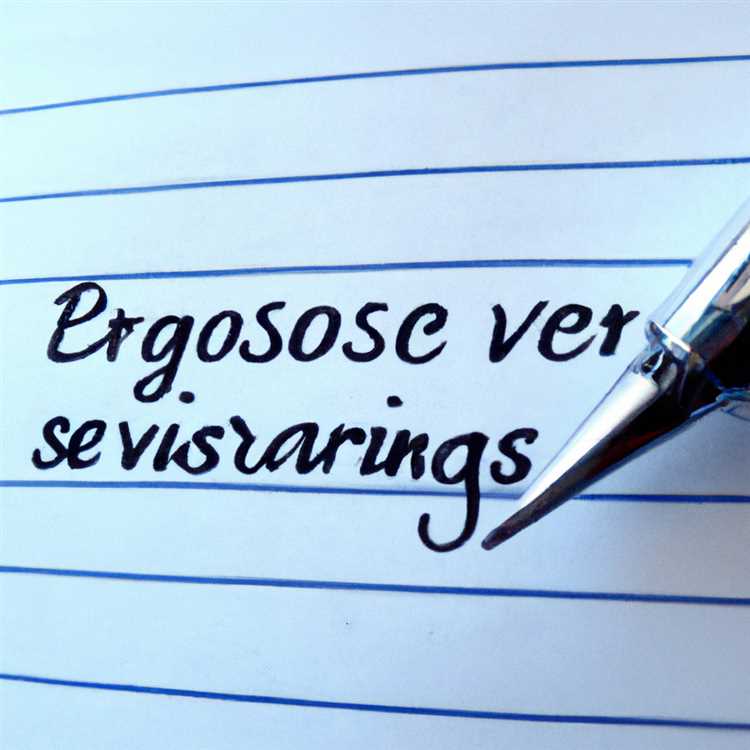
Writing essays can be a challenging task, but with the right approach and strategies, you can create compelling and impactful pieces that captivate your audience. Whether you’re a student working on an academic paper or a professional honing your writing skills, these tips will help you craft essays that stand out.
Effective essays are not just about conveying information; they are about persuading, engaging, and inspiring readers. To achieve this, it’s essential to pay attention to various elements of the essay-writing process, from brainstorming ideas to polishing your final draft. By following these tips, you can elevate your writing and produce essays that leave a lasting impression.
Understanding the Essay Prompt
Before you start writing your essay, it is crucial to thoroughly understand the essay prompt or question provided by your instructor. The essay prompt serves as a roadmap for your essay and outlines the specific requirements or expectations.
Here are a few key things to consider when analyzing the essay prompt:
- Read the prompt carefully and identify the main topic or question being asked.
- Pay attention to any specific instructions or guidelines provided, such as word count, formatting requirements, or sources to be used.
- Identify key terms or phrases in the prompt that can help you determine the focus of your essay.
By understanding the essay prompt thoroughly, you can ensure that your essay addresses the topic effectively and meets the requirements set forth by your instructor.
Researching Your Topic Thoroughly

One of the key elements of writing an effective essay is conducting thorough research on your chosen topic. Research helps you gather the necessary information, facts, and examples to support your arguments and make your essay more convincing.
Here are some tips for researching your topic thoroughly:
By following these tips and conducting thorough research on your topic, you will be able to write a well-informed and persuasive essay that effectively communicates your ideas and arguments.
Creating a Strong Thesis Statement
A thesis statement is a crucial element of any well-crafted essay. It serves as the main point or idea that you will be discussing and supporting throughout your paper. A strong thesis statement should be clear, specific, and arguable.
To create a strong thesis statement, follow these tips:
- Be specific: Your thesis statement should clearly state the main idea of your essay. Avoid vague or general statements.
- Be concise: Keep your thesis statement concise and to the point. Avoid unnecessary details or lengthy explanations.
- Be argumentative: Your thesis statement should present an argument or perspective that can be debated or discussed in your essay.
- Be relevant: Make sure your thesis statement is relevant to the topic of your essay and reflects the main point you want to make.
- Revise as needed: Don’t be afraid to revise your thesis statement as you work on your essay. It may change as you develop your ideas.
Remember, a strong thesis statement sets the tone for your entire essay and provides a roadmap for your readers to follow. Put time and effort into crafting a clear and compelling thesis statement to ensure your essay is effective and persuasive.
Developing a Clear Essay Structure
One of the key elements of writing an effective essay is developing a clear and logical structure. A well-structured essay helps the reader follow your argument and enhances the overall readability of your work. Here are some tips to help you develop a clear essay structure:
1. Start with a strong introduction: Begin your essay with an engaging introduction that introduces the topic and clearly states your thesis or main argument.
2. Organize your ideas: Before you start writing, outline the main points you want to cover in your essay. This will help you organize your thoughts and ensure a logical flow of ideas.
3. Use topic sentences: Begin each paragraph with a topic sentence that introduces the main idea of the paragraph. This helps the reader understand the purpose of each paragraph.
4. Provide evidence and analysis: Support your arguments with evidence and analysis to back up your main points. Make sure your evidence is relevant and directly supports your thesis.
5. Transition between paragraphs: Use transitional words and phrases to create flow between paragraphs and help the reader move smoothly from one idea to the next.
6. Conclude effectively: End your essay with a strong conclusion that summarizes your main points and reinforces your thesis. Avoid introducing new ideas in the conclusion.
By following these tips, you can develop a clear essay structure that will help you effectively communicate your ideas and engage your reader from start to finish.
Using Relevant Examples and Evidence
When writing an essay, it’s crucial to support your arguments and assertions with relevant examples and evidence. This not only adds credibility to your writing but also helps your readers better understand your points. Here are some tips on how to effectively use examples and evidence in your essays:
- Choose examples that are specific and relevant to the topic you’re discussing. Avoid using generic examples that may not directly support your argument.
- Provide concrete evidence to back up your claims. This could include statistics, research findings, or quotes from reliable sources.
- Interpret the examples and evidence you provide, explaining how they support your thesis or main argument. Don’t assume that the connection is obvious to your readers.
- Use a variety of examples to make your points more persuasive. Mixing personal anecdotes with scholarly evidence can make your essay more engaging and convincing.
- Cite your sources properly to give credit to the original authors and avoid plagiarism. Follow the citation style required by your instructor or the publication you’re submitting to.
By integrating relevant examples and evidence into your essays, you can craft a more convincing and well-rounded piece of writing that resonates with your audience.
Editing and Proofreading Your Essay Carefully
Once you have finished writing your essay, the next crucial step is to edit and proofread it carefully. Editing and proofreading are essential parts of the writing process that help ensure your essay is polished and error-free. Here are some tips to help you effectively edit and proofread your essay:
1. Take a Break: Before you start editing, take a short break from your essay. This will help you approach the editing process with a fresh perspective.
2. Read Aloud: Reading your essay aloud can help you catch any awkward phrasing or grammatical errors that you may have missed while writing. It also helps you check the flow of your essay.
3. Check for Consistency: Make sure that your essay has a consistent style, tone, and voice throughout. Check for inconsistencies in formatting, punctuation, and language usage.
4. Remove Unnecessary Words: Look for any unnecessary words or phrases in your essay and remove them to make your writing more concise and clear.
5. Proofread for Errors: Carefully proofread your essay for spelling, grammar, and punctuation errors. Pay attention to commonly misused words and homophones.
6. Get Feedback: It’s always a good idea to get feedback from someone else. Ask a friend, classmate, or teacher to review your essay and provide constructive feedback.
By following these tips and taking the time to edit and proofread your essay carefully, you can improve the overall quality of your writing and make sure your ideas are effectively communicated to your readers.
Related Post
How to master the art of writing expository essays and captivate your audience, convenient and reliable source to purchase college essays online, step-by-step guide to crafting a powerful literary analysis essay, unlock success with a comprehensive business research paper example guide, unlock your writing potential with writers college – transform your passion into profession, “unlocking the secrets of academic success – navigating the world of research papers in college”, master the art of sociological expression – elevate your writing skills in sociology.

How to Write a Book Title in an Essay (+48 Examples)
Knowing how to properly format book titles in your essay is crucial. This guide will walk you through the various rules and conventions, ensuring that your writing is polished and professional.
Here’s how to write a book title in an essay.
Basic Rules for Writing a Book Title in an Essay
Let’s get right into the basic rules that you will use most of the time.
Italicize Book Titles
In most style guides, such as MLA, APA, and Chicago, book titles should be italicized. This helps to distinguish the title from the rest of the text and makes it clear to the reader.
- Correct: To Kill a Mockingbird
- Incorrect: To Kill a Mockingbird
Use Quotation Marks for Shorter Works
Shorter works, such as articles, essays, chapters, and short stories, should be placed in quotation marks.
- Correct: “The Lottery” by Shirley Jackson
- Incorrect: The Lottery by Shirley Jackson
How to Write a Book Title in Different Scenarios

Table of Contents
Of course, sometimes, you’ll run into different situations where you might need to change how you write book titles in your essays.
In this section, I’ll cover as many of these scenarios as possible, along with examples.
1. MLA Format
In MLA format, book titles are italicized. If you are writing an essay in MLA format, ensure that you follow this rule.
Additionally, titles of articles, essays, chapters, and web pages should be placed in quotation marks.
This style is commonly used in humanities and liberal arts. MLA format emphasizes the clarity of source titles, helping to avoid confusion and ensure proper citation.
MLA guidelines help maintain consistency across academic writing, making it easier for readers to follow and understand references.
- Correct: In The Great Gatsby , F. Scott Fitzgerald explores themes of decadence and idealism.
- Correct: The chapter titled “The Custom-House” in The Scarlet Letter provides essential background.
2. APA Format
APA format also requires book titles to be italicized.
This style is commonly used in the social sciences. Titles of articles, chapters, and other shorter works are placed in quotation marks.
APA format focuses on date-driven citations, so the book title should stand out to help the reader quickly identify the source.
Using italics for book titles in APA ensures clarity and consistency, helping to distinguish the titles from other elements of the citation.
- Correct: The study is detailed in The Psychology of Learning .
- Correct: In the book Thinking, Fast and Slow , Daniel Kahneman discusses cognitive biases.
3. Chicago Style
Chicago style, used in history and other disciplines, also calls for book titles to be italicized.
This format is flexible and allows for both footnotes and endnotes.
Titles of articles, chapters, and shorter works are placed in quotation marks. The Chicago Manual of Style provides extensive guidelines for source citation and text formatting.
By italicizing book titles, Chicago style ensures that references are clear and unambiguous, aiding readers in locating the sources.
- Correct: The author of War and Peace is Leo Tolstoy.
- Correct: In her analysis, the book Pride and Prejudice is frequently cited.
4. In-Text Citations
When referencing a book title in the body of your essay, it should be italicized.
If you are referring to a specific chapter or section, place the title of the chapter in quotation marks.
This ensures clarity and helps the reader distinguish between the book title and other elements of your text.
In-text citations need to be precise and clear to ensure that the reader can easily identify the source material and verify the information.
- Correct: The theme of betrayal in 1984 is evident throughout the novel.
- Correct: The essay “Self-Reliance” by Ralph Waldo Emerson is often quoted in academic circles.
5. In a Works Cited Page
In your works cited page, format book titles according to the style guide you are using.
For MLA, APA, and Chicago styles, book titles should be italicized.
This section provides full bibliographic details, making it easy for readers to locate your sources.
Properly formatting book titles in your works cited page ensures that your references are clear and consistent, which is crucial for academic integrity and credibility.
- MLA: Fitzgerald, F. Scott. The Great Gatsby . Scribner, 2004.
- APA: Fitzgerald, F. S. (2004). The Great Gatsby . Scribner.
- Chicago: Fitzgerald, F. Scott. The Great Gatsby . New York: Scribner, 2004.
6. Handwritten Essays
If you are writing an essay by hand, underline book titles instead of italicizing them.
This is because italics can be difficult to distinguish in handwritten text.
Underlining provides a clear way to differentiate book titles from the rest of your writing.
In handwritten essays, maintaining clear and legible formatting is important to ensure that the reader can easily recognize book titles and other elements of your text.
- Correct: Moby Dick should be underlined in a handwritten essay.
- Incorrect: Moby Dick should not be italicized in a handwritten essay.
7. Titles Within Titles
If a book title appears within another book title, italicize the main title and use quotation marks for the title within the title.
This distinction helps clarify the structure of the titles and ensures that each component is properly formatted.
Formatting titles within titles correctly avoids confusion and maintains the clarity and readability of your text.
- Correct: She read A Study of “The Raven” by Edgar Allan Poe .
- Correct: His analysis in Understanding “Moby Dick” was groundbreaking.
8. Multiple Works by the Same Author
When referencing multiple works by the same author in an essay, list the titles in italics and separate them with commas.
This formatting helps readers easily identify the different works and understand the scope of the author’s contributions.
Properly formatting multiple works by the same author ensures that your references are clear and organized, making it easier for readers to follow your analysis.
- Correct: Orwell’s 1984 , Animal Farm , and Homage to Catalonia all critique social structures.
- Correct: Austen’s novels, Pride and Prejudice , Emma , and Sense and Sensibility , are classics.
9. In a Bibliography
In a bibliography, book titles should be italicized, and other details should follow the respective style guide’s rules.
This ensures that your sources are listed correctly and consistently, making it easy for readers to find them.
A properly formatted bibliography is essential for academic integrity, providing a clear and comprehensive record of the sources you have used.
- MLA: Orwell, George. 1984 . Secker & Warburg, 1949.
- APA: Orwell, G. (1949). 1984 . Secker & Warburg.
- Chicago: Orwell, George. 1984 . London: Secker & Warburg, 1949.
10. In a Research Paper
In research papers, book titles should be italicized, and any specific sections, like chapters or essays, should be in quotation marks.
This clear differentiation helps readers distinguish between the entire work and individual parts.
Proper formatting in research papers ensures that your references are clear and professional, making it easy for readers to verify your sources.
- Correct: The character development in The Catcher in the Rye is significant.
- Correct: The chapter “The Catcher in the Rye” in Salinger’s book highlights the main theme.
11. In a Thesis or Dissertation
Theses and dissertations require strict adherence to formatting rules, so ensure book titles are italicized.
Proper formatting in these extensive research papers demonstrates attention to detail and adherence to academic standards.
Italicizing book titles in a thesis or dissertation helps maintain consistency and professionalism, which is crucial for the credibility of your work.
- Correct: The influence of Crime and Punishment on modern psychology is evident.
- Correct: In her dissertation, she cited Brave New World extensively.
12. In a Presentation
When preparing a presentation, italicize book titles in your slides or handouts to maintain professional formatting.
This practice ensures that your presentation is clear and visually appealing, reinforcing your points effectively.
Properly formatting book titles in presentations enhances the readability and professionalism of your slides, making your information more accessible to the audience.
- Correct: Key themes in To Kill a Mockingbird include justice and morality.
- Correct: The impact of The Iliad on literature cannot be overstated.
13. In a Discussion Post
When writing discussion posts for online classes or forums, italicize book titles to follow proper formatting.
This helps maintain clarity and ensures your posts are taken seriously by other participants.
Properly formatting book titles in discussion posts demonstrates your attention to detail and respect for academic conventions, enhancing the credibility of your contributions.
- Correct: I found The Great Gatsby to be a profound critique of the American Dream.
- Correct: In Frankenstein , Mary Shelley explores themes of creation and responsibility.
14. In a Book Review
In book reviews, the title of the book being reviewed should be italicized to clearly distinguish it from the rest of the text.
This practice ensures that readers can easily identify the book you are discussing.
Properly formatting book titles in reviews enhances the readability and professionalism of your writing, making your review more engaging and credible.
- Correct: The Road by Cormac McCarthy is a haunting tale of survival.
- Correct: In her review of Beloved , she highlights the emotional depth of the narrative.
15. In a Literary Analysis
Literary analysis essays should follow the same formatting rules, with book titles italicized.
This helps distinguish the titles from other parts of the text, making your analysis clear and organized.
Proper formatting in literary analysis ensures that your references are easily identifiable and enhances the overall professionalism of your essay.
- Correct: The symbolism in The Scarlet Letter is intricate and multifaceted.
- Correct: Macbeth by Shakespeare is a study in ambition and power.
16. In a Creative Writing Piece
Even in creative writing, when referencing other works, book titles should be italicized to maintain clarity.
Proper formatting ensures that your references are easily identifiable, even in a more informal context.
Italicizing book titles in creative writing helps to maintain consistency and professionalism, enhancing the readability and credibility of your work.
- Correct: She often thought of herself as a modern-day Elizabeth Bennet from Pride and Prejudice .
- Correct: His journey felt like something out of The Hobbit .
17. In a History Essay
In history essays, book titles are italicized, and other works such as articles or chapters are placed in quotation marks.
This formatting helps clarify sources and makes your essay more professional.
Properly formatting book titles in history essays ensures that your references are clear and easily distinguishable, enhancing the credibility and readability of your work.
- Correct: The events in All Quiet on the Western Front illustrate the horrors of war.
- Correct: In the book The Guns of August , the causes of WWI are detailed.
18. In a Science Paper
Even in science papers, book titles should be italicized to ensure professional and clear presentation.
This practice helps to maintain consistency and clarity in your citations and references.
Properly formatting book titles in science papers ensures that your sources are easily identifiable and enhances the overall professionalism of your work.
- Correct: The theories in The Origin of Species revolutionized biology.
- Correct: In his book A Brief History of Time , Stephen Hawking explores complex physics concepts.
19. In a Philosophy Paper
Philosophy papers require careful citation, with book titles italicized and other works properly formatted.
Accurate formatting reflects a commitment to scholarly rigor and helps readers locate your sources easily.
Properly formatting book titles in philosophy papers ensures that your references are clear and professional, enhancing the credibility and readability of your work.
- Correct: Plato’s The Republic is fundamental to understanding his philosophy.
- Correct: The ideas in Being and Time by Heidegger are complex and profound.
20. In a Law Essay
Law essays often reference important texts and cases, with book titles italicized for clarity.
Proper formatting ensures that your legal citations are clear and professional, facilitating easy reference.
Italicizing book titles in law essays helps to maintain consistency and clarity, making your references easily identifiable and enhancing the overall professionalism of your work.
- Correct: In The Common Law , Oliver Wendell Holmes outlines fundamental legal principles.
- Correct: The casebook Constitutional Law is widely used in legal education.
21. In a Social Studies Essay
Social studies essays should also follow proper formatting rules, with book titles italicized.
This practice helps to clearly distinguish the sources and enhances the readability of your essay.
Properly formatting book titles in social studies essays ensures that your references are clear and consistent, making it easier for readers to locate your sources and enhancing the credibility of your work.
- Correct: The impact of Silent Spring on environmental policy was significant.
- Correct: In Guns, Germs, and Steel , Jared Diamond explores the factors influencing human societies.
Here is a good video about how to write a book title in an essay:
Summary Chart: How to Write a Book Title in an Essay
Final thoughts.
By following the formatting rules outlined in this guide, you can ensure that your writing is clear, professional, and polished.
For more guides on writing essays (and more), check out some of our other blog posts below.
Read This Next
- How to Write an Abstract (Ultimate Guide + 13 Examples)
- RACE Writing: A Comprehensive Guide + Examples
- How to Describe a Graph in Writing [+ 22 Examples]
- Best AI Essay Writer (With Examples)
- 21 Best Ways To Write Essays When You Are Stuck [Examples]

IMAGES
VIDEO
COMMENTS
Learn the essay writing process from preparation to revision with this beginner's guide. Find out how to choose a topic, do research, create an outline, write an introduction and conclusion, and avoid common mistakes.
Learn how to write an essay from scratch using a simple example. Follow the 6-step process of deciding on your main point, coming up with supporting ideas, writing a thesis statement, writing the body, and adding an introduction and a conclusion.
There are three main stages to writing an essay: preparation, writing and revision. In just 4 minutes, this video will walk you through each stage of an acad...
Learn to write an essay from the outline to the draft with this video tutorial. It covers how to write a hook, thesis statement, body paragraphs, and conclusion, and provides pdfs to practice.
Knowing how to begin a college essay is daunting. It can be hard to write an engaging, authentic opener. But without an interesting hook, you risk getting lost in a vast sea of applications. To this end, we've put together some techniques about how to start a college essay to make your DTDT moment a little smoother and a little less stressful.
Learn how to write an essay with this comprehensive guide that covers planning, writing, and editing. Find examples, tips, and tricks for different types of essays and topics.
Read your assignment carefully. The style, structure, and focus of your essay will vary depending on the type of essay you are writing. If you've been assigned to write an essay for a class, review the assignment carefully and look for information about the nature of the essay.
Learn the basics of essay structure and how to organize information within the body. Find useful templates and examples for different approaches: chronological, compare-and-contrast, and problems-methods-solutions.
Learn the basics of essay writing, from generating ideas and picking a type of essay to revising and proofreading. Follow the five-step process and the essay structure to create a compelling and well-organized essay.
Learn how to read an assignment prompt, ask analytical questions, write a thesis, and organize your essay with this guide from the Harvard Writing Center. Find tips for introductions, body paragraphs, transitions, counterarguments, and conclusions.
Learn how to structure an essay with this example of a well-written academic paper. It covers the introduction, body paragraphs, and conclusion, and explains the key features and functions of each section.
Learn different ways to write an essay introduction, such as using facts, questions, scenes, quotes, or thesis statements. Find out how to hook your reader's attention and choose the right tone for your essay.
Learn the basics of essay writing, from types of essays to stages of writing, with helpful tips and examples. Find out how to structure an essay with introduction, body, and conclusion, and how to revise your work.
Learn the art of essay writing with this comprehensive guide. Find out how to choose a topic, structure your essay, craft a thesis statement, and more.
Download PDFs of tips and guides for writing essays in various disciplines and formats. Learn how to read assignment prompts, ask analytical questions, write introductions, body paragraphs, transitions, conclusions, and more.
Learn how to craft engaging and persuasive essays with these tips on understanding the prompt, researching your topic, creating a thesis, developing a structure, using examples, and editing. This guide covers various aspects of the essay-writing process and provides examples and strategies to help you improve your skills.
Learn how to write an effective introduction paragraph for your academic essay with this guide. It covers the main goals, steps and tips for hooking your reader, giving background information, presenting your thesis statement and mapping your essay structure.
Learn the basic rules and conventions for formatting book titles in your essay, such as italicizing, quotation marks, and in-text citations. See examples for different scenarios and style guides, such as MLA, APA, and Chicago.